Top Rankings
May-Port Cg 14 School District ranks among the top 20% of public school district in North Dakota for:
Category
Attribute
Graduation Rate
Highest graduation rate (Top 20%)
For the 2025 school year, there are 3 public schools serving 511 students in May-Port Cg 14 School District. This district's average testing ranking is 7/10, which is in the top 50% of public schools in North Dakota.
Public Schools in May-Port Cg 14 School District have an average math proficiency score of 44% (versus the North Dakota public school average of 39%), and reading proficiency score of 50% (versus the 44% statewide average).
Minority enrollment is 13% of the student body (majority Hispanic), which is less than the North Dakota public school average of 29% (majority American Indian and Hispanic).
Overview
This School District
This State (ND)
# Schools
3 Schools
537 Schools
# Students
511 Students
122,294 Students
# Teachers
46 Teachers
9,926 Teachers
Student : Teacher Ratio
11:1
11:1
District Rank
May-Port Cg 14 School District, which is ranked within the top 50% of all 167 school districts in North Dakota (based off of combined math and reading proficiency testing data) for the 2021-2022 school year.
The school district's graduation rate of 80-89% has decreased from 90% over five school years.
Overall District Rank
#62 out of 169 school districts
(Top 50%)
(Top 50%)
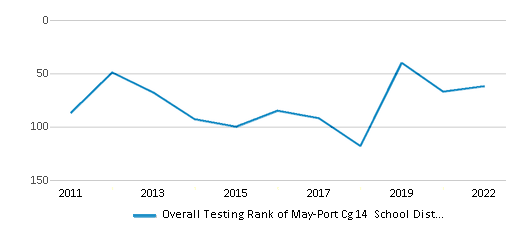
Math Test Scores (% Proficient)
42%
39%
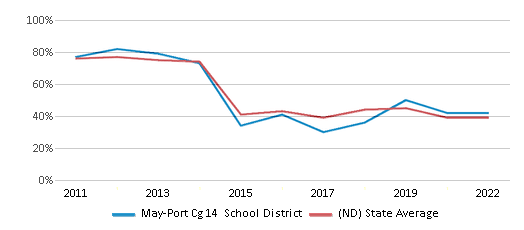
Reading/Language Arts Test Scores (% Proficient)
50%
44%
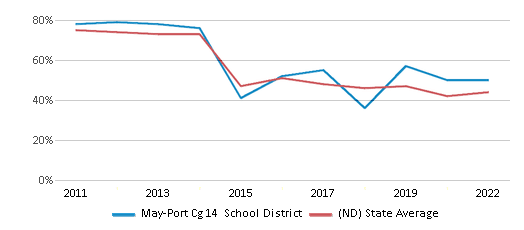
Science Test Scores (% Proficient)
35-39%
44%
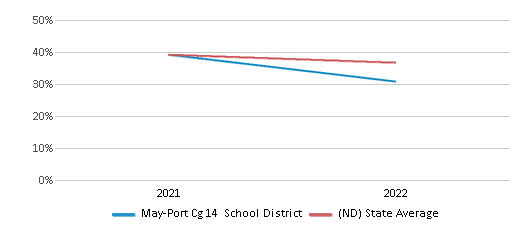
Graduation Rate
80-89%
85%
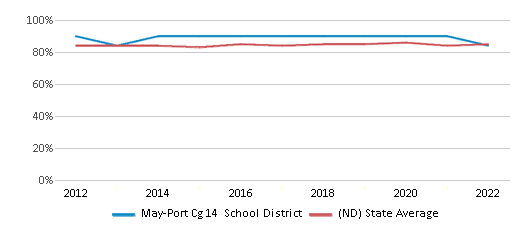
Students by Ethnicity:
Diversity Score
0.23
0.48
# American Indian Students
14 Students
13,083 Students
% American Indian Students
3%
11%
# Asian Students
n/a
1,750 Students
% Asian Students
n/a
1%
# Hispanic Students
34 Students
8,341 Students
% Hispanic Students
7%
7%
# Black Students
3 Students
6,529 Students
% Black Students
1%
5%
# White Students
446 Students
86,623 Students
% White Students
87%
71%
# Hawaiian Students
2 Students
374 Students
% Hawaiian Students
n/a
n/a
# Two or more races Students
12 Students
5,594 Students
% of Two or more races Students
2%
5%
Students by Grade:
# Students in PK Grade:
7
3,099
# Students in K Grade:
31
8,897
# Students in 1st Grade:
36
9,525
# Students in 2nd Grade:
49
9,752
# Students in 3rd Grade:
37
9,340
# Students in 4th Grade:
46
9,408
# Students in 5th Grade:
37
9,314
# Students in 6th Grade:
48
9,461
# Students in 7th Grade:
39
9,001
# Students in 8th Grade:
30
9,080
# Students in 9th Grade:
42
9,428
# Students in 10th Grade:
35
9,162
# Students in 11th Grade:
41
8,623
# Students in 12th Grade:
33
8,204
# Ungraded Students:
-
-
District Revenue and Spending
The revenue/student of $14,382 in this school district is less than the state median of $17,615. The school district revenue/student has stayed relatively flat over four school years.
The school district's spending/student of $13,877 is less than the state median of $17,617. The school district spending/student has stayed relatively flat over four school years.
Total Revenue
$7 MM
$2,154 MM
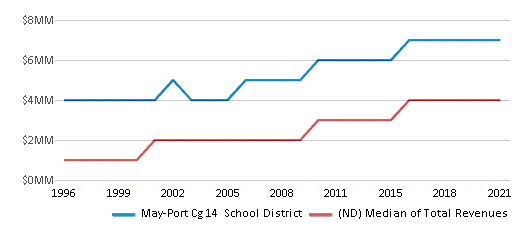
Spending
$7 MM
$2,154 MM
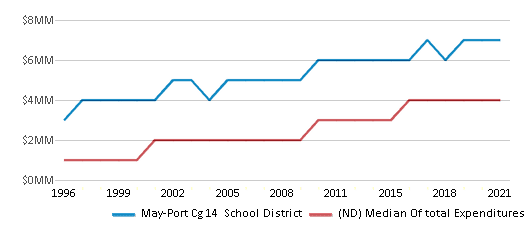
Revenue / Student
$14,382
$17,615
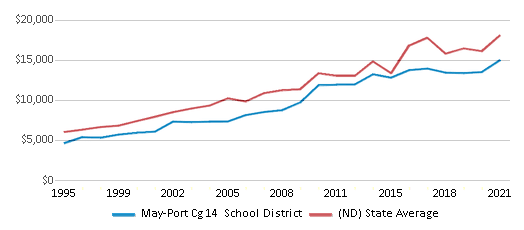
Spending / Student
$13,877
$17,617
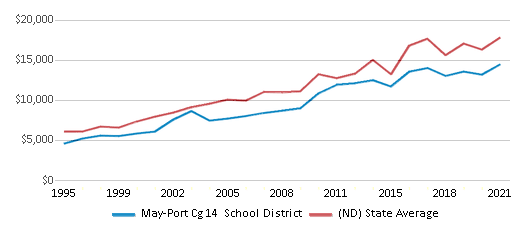
Best May-Port Cg 14 School District Public Schools (2025)
School
(Math and Reading Proficiency)
(Math and Reading Proficiency)
Location
Grades
Students
Rank: #11.
Peter Boe Jr Elementary School
(Math: 50-54% | Reading: 55-59%)
Rank:
Rank:
10/
Top 10%10
20 2nd St Nw
Mayville, ND 58257
(701) 788-2116
Mayville, ND 58257
(701) 788-2116
Grades: PK-5
| 243 students
Rank: #22.
May-port Cg High School
(Math: 40-59% | Reading: 40-59%)
Rank:
Rank:
7/
Top 50%10
900 Main St W
Mayville, ND 58257
(701) 788-2281
Mayville, ND 58257
(701) 788-2281
Grades: 9-12
| 151 students
Rank: #33.
May-port Cg Middle School
(Math: 30-34% | Reading: 40-44%)
Rank:
Rank:
4/
Bottom 50%10
900 Main St W
Mayville, ND 58257
(701) 788-2281
Mayville, ND 58257
(701) 788-2281
Grades: 6-8
| 117 students
Frequently Asked Questions
How many schools belong to May-Port Cg 14 School District?
May-Port Cg 14 School District manages 3 public schools serving 511 students.
What is the rank of May-Port Cg 14 School District?
May-Port Cg 14 School District is ranked #58 out of 167 school districts in North Dakota (top 50%) based off of combined math and reading proficiency testing data for the 2021-2022 school year. This district ranks in the top 20% of North Dakota school districts for: Highest graduation rate (Top 20%)
What is the racial composition of students in May-Port Cg 14 School District?
87% of May-Port Cg 14 School District students are White, 7% of students are Hispanic, 3% of students are American Indian, 2% of students are Two or more races, and 1% of students are Black.
What is the student/teacher ratio of May-Port Cg 14 School District?
May-Port Cg 14 School District has a student/teacher ratio of 11:1, which is lower than the North Dakota state average of 12:1.
What is May-Port Cg 14 School District's spending/student ratio?
The school district's spending/student of $13,877 is less than the state median of $17,617. The school district spending/student has stayed relatively flat over four school years.
Recent Articles

Year-Round Or Traditional Schedule?
Which is more appropriate for your child? A year-round attendance schedule or traditional schedule? We look at the pros and cons.

Why You Should Encourage Your Child to Join a Sports Team
Participating in team sports has a great many benefits for children, there is no doubt. In this article you will learn what those benefits are.

White Students are Now the Minority in U.S. Public Schools
Increasing birth rates among immigrant families from Asia and Central and South America, combined with lower birth rates among white families, means that for the first time in history, public school students in the United States are majority-minority. This shift in demographics poses difficulties for schools as they work to accommodate children of varying language abilities and socio-economic backgrounds.





